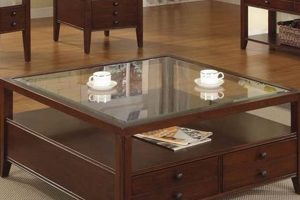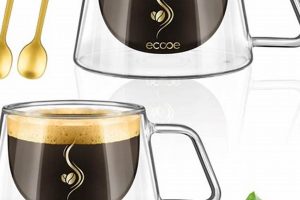A transparent vessel designed for brewing coffee, often made of borosilicate glass to withstand high temperatures. It allows users to visually monitor the brewing process. An example includes a pour-over style carafe or a Chemex brewer, which commonly utilize paper filters for a sediment-free beverage.
The use of such a brewing method offers several advantages. The inert nature of the material ensures that no unwanted flavors are imparted to the coffee. This neutrality allows for a purer taste profile, enhancing the nuances of the coffee beans. Historically, this type of coffee preparation has been favored for its simplicity and the control it affords the user over factors like water temperature and brewing time.
The subsequent sections of this discussion will delve into specific design considerations, cleaning protocols, and comparative analyses with other brewing methods, exploring the practical aspects of using this type of equipment and considerations for optimal coffee extraction.
Glass Coffee Pot
The following guidelines are provided to ensure optimal performance and longevity of the brewing apparatus. Adherence to these recommendations contributes to a consistent and satisfactory coffee preparation experience.
Tip 1: Preheating the Vessel: Before initiating the brewing process, rinse the apparatus with hot water. This practice minimizes thermal shock and maintains a stable brewing temperature, facilitating even extraction.
Tip 2: Grind Size Selection: Employ a medium-coarse grind for pour-over methods. A finer grind may result in over-extraction and a bitter taste, while a coarser grind may lead to under-extraction and a weak brew.
Tip 3: Water Temperature Management: Utilize water heated to a temperature between 195-205F (90-96C). This temperature range promotes optimal extraction of desirable compounds from the coffee grounds.
Tip 4: Controlled Pouring Technique: When using a pour-over method, saturate the grounds evenly during the bloom phase, allowing the coffee to degas. Subsequently, pour water in a slow, circular motion to ensure consistent saturation.
Tip 5: Prompt Cleaning After Use: Following each brewing session, thoroughly clean the apparatus with warm, soapy water. Residue buildup can negatively impact future brews and potentially damage the material over time.
Tip 6: Descaling Regularly: Periodically descale the apparatus using a solution of vinegar and water. Mineral deposits can accumulate and affect the brewing process, leading to reduced efficiency.
Proper utilization and maintenance are crucial for realizing the full potential of this brewing method. Consistent application of these techniques will yield a superior coffee beverage and extend the lifespan of the equipment.
The subsequent section will explore various coffee bean characteristics and their influence on the final cup, expanding upon the nuances of the brewing process.
1. Material Transparency
The inherent clarity of the glass substance used in the creation of coffee brewing vessels facilitates direct visual assessment of the brewing process. This transparency provides immediate feedback on crucial aspects such as the saturation level of the coffee grounds, the consistency of the extraction, and the presence of any undesirable sediment or inconsistencies during the brewing cycle. This direct observation capability allows the user to adjust their technique in real-time, ensuring optimal brewing conditions. For instance, spotting channeling early during a pour-over allows for immediate correction, which would not be possible with opaque brewing methods.
Furthermore, this attribute enables observation of the coffee’s color and clarity as it brews. Changes in color intensity or the presence of cloudiness are easily detectable, indicating potential problems with water temperature, grind size, or the quality of the coffee beans themselves. An instance of this utility can be seen when evaluating the impact of different grind sizes on the extraction. A too-fine grind might show an overly dark, almost muddy extraction through the glass, allowing the user to immediately adjust their future preparations. This visibility directly contributes to a more controlled and consistent brewing experience, leading to enhanced coffee quality.
In conclusion, material clarity significantly enhances the brewing process. The ability to visually monitor and adjust parameters based on real-time observation is a major benefit. By ensuring an informed approach to brewing, users are equipped to obtain the best possible results, maximizing the coffee’s potential. The practical significance of this material attribute lies in enabling a more controlled and personalized brewing experience, ultimately improving the quality of the final cup.
2. Thermal Resistance
Thermal resistance, the capacity to withstand significant temperature variations without structural compromise, is a critical property for any apparatus intended for hot beverage preparation. Its significance in the context of the glass coffee pot is paramount, directly impacting durability, safety, and the overall coffee brewing process.
- Borosilicate Composition
The use of borosilicate glass is prevalent in the manufacturing of these brewing devices due to its superior thermal resistance compared to standard glass. This specific composition minimizes the risk of cracking or shattering when exposed to rapid temperature changes, such as the introduction of boiling water during the brewing cycle. For example, many high-end pour-over carafes are explicitly constructed from borosilicate glass to guarantee their stability under demanding conditions.
- Minimizing Thermal Shock
Rapid temperature fluctuations, or thermal shock, can induce stress within the glass material, potentially leading to failure. The heightened thermal resistance of the glass slows the rate of temperature change, reducing the stress concentration. Pre-heating the apparatus with warm water prior to brewing further mitigates thermal shock by gradually raising the glass temperature, preparing it for the introduction of hotter water.
- Maintaining Brewing Temperature
The thermal properties of the glass contribute to the maintenance of a stable brewing temperature throughout the extraction process. While not as insulative as other materials, the specific type of glass used in the construction of such devices helps to minimize heat loss, promoting a consistent extraction environment and subsequently influencing the flavor profile of the final brew. This is especially critical in temperature-sensitive brewing methods such as pour-over, where even small fluctuations can noticeably impact the final result.
- Safety Considerations
The use of glass with high thermal shock resistance is fundamentally related to user safety. The potential shattering of a vessel during the coffee brewing process could result in serious injury. By choosing materials and designs that prioritize thermal stability, manufacturers aim to minimize the likelihood of such incidents, ensuring a safer brewing experience for the consumer. The enhanced resistance to cracking is essential for reducing risks.
The various facets of thermal resistance are intrinsically linked to the usability and safety of brewing devices. These material properties facilitate efficient and safe coffee preparation while providing a stable environment for flavor extraction. These factors all contribute to a positive and reliable user experience.
3. Pour-Over Compatibility
The design characteristics of a glass coffee pot frequently complement the pour-over brewing method, facilitating a controlled and visually monitored coffee extraction. This compatibility is not merely coincidental but rather a result of specific design considerations that enhance the functionality and precision of manual coffee preparation.
- Optimal Vessel Shape for Controlled Pouring
Glass coffee pots designed for pour-over often feature a conical or hourglass shape, which promotes a consistent water flow through the coffee grounds. This design encourages even saturation and extraction, minimizing channeling and ensuring a balanced flavor profile. For example, the Hario V60 utilizes this conical shape. This controlled pouring is an integral part of the pour-over brewing process.
- Heat Retention Characteristics
The inherent thermal properties of glass, particularly borosilicate glass, contribute to maintaining a stable brewing temperature during the pour-over process. While glass is not as insulative as some materials, it still helps to mitigate temperature fluctuations. These characteristics, coupled with preheating the pot, are conducive to a consistent extraction, influencing the ultimate taste and quality of the brewed coffee.
- Visual Monitoring Capabilities
The transparency of glass enables direct observation of the coffee slurry and the extraction process. This visual feedback allows the user to adjust their pouring technique in real-time, correcting any inconsistencies or channeling that may occur. The capacity to visually monitor and react accordingly is a distinct advantage offered by glass vessels designed for pour-over brewing.
- Filter Support Systems
Specific models of glass coffee pots incorporate built-in filter support systems, designed to accommodate paper or reusable filters directly. This integration streamlines the brewing process, providing a secure and stable platform for extraction while minimizing the potential for grounds to bypass the filter. A Chemex is one example of a system with a built-in filter support.
The synergistic relationship between a glass coffee pot and the pour-over brewing method stems from deliberate design features and the material properties of glass. The combination provides users with a visually controlled and adaptable brewing environment conducive to producing high-quality coffee.
4. Cleaning Simplicity
The ease with which a coffee brewing apparatus can be cleaned directly influences user satisfaction and the longevity of the equipment. Cleaning simplicity is an inherent advantage afforded by many glass coffee pots, stemming from the material’s non-porous nature and the often uncomplicated designs employed in their construction. The subsequent discussion will explore specific facets of this attribute.
- Non-Porous Surface
Glass, being a non-porous material, resists the absorption of coffee oils and residues. These oils, if allowed to accumulate, can impart undesirable flavors to subsequent brews. The smooth surface of glass facilitates the removal of these residues with relative ease, typically requiring only warm water and mild detergent. In contrast, porous materials like some plastics can retain flavors and odors despite thorough cleaning.
- Simple Design and Geometry
Many glass coffee pots feature uncomplicated designs with smooth internal surfaces and minimal crevices. This simplicity reduces the number of areas where coffee grounds and oils can become trapped, streamlining the cleaning process. The absence of intricate components or hard-to-reach areas contributes to the speed and efficiency of cleaning. Compare this design to more complex automatic coffee makers with multiple components that necessitate dismantling for proper cleaning.
- Visual Inspection for Residue
The transparency of glass allows for immediate visual inspection to confirm the complete removal of coffee residue. This visual confirmation eliminates guesswork and ensures that the apparatus is thoroughly cleaned after each use. The ability to easily identify remaining residue allows for targeted cleaning efforts, preventing the buildup of stubborn stains and flavors. Opaque materials do not offer this advantage, potentially leading to unnoticed residue accumulation.
- Dishwasher Compatibility
Certain glass coffee pots are explicitly designed to be dishwasher-safe, further simplifying the cleaning process. This compatibility allows for automated cleaning, eliminating the need for manual scrubbing and rinsing. The high temperatures and detergents used in dishwashers effectively remove coffee residues, sanitizing the apparatus and preparing it for subsequent use. Always check the manufacturer’s instructions to verify that the specific model is indeed dishwasher-safe.
The facets of cleaning simplicity contribute significantly to the overall user experience with a glass coffee pot. The ease and efficiency of maintaining a clean brewing environment promotes consistent coffee quality and prolongs the lifespan of the apparatus, making it a desirable choice for coffee enthusiasts.
5. Flavor Neutrality
The concept of flavor neutrality is paramount in the realm of coffee brewing, particularly when considering the selection of materials for coffee preparation devices. Glass, specifically borosilicate glass, exhibits a high degree of flavor neutrality. This inertness is crucial as it prevents the leaching of unwanted flavors into the brewed coffee, ensuring that the final beverage retains the pure and unadulterated characteristics of the chosen coffee beans. For instance, a plastic coffee maker, over time, can impart a distinct plastic taste to the brewed coffee, masking the subtle nuances of the beans. Glass, however, avoids this contamination. This absence of imparted flavors allows the inherent qualities of the coffee itself to be fully appreciated by the consumer.
Flavor neutrality directly impacts the sensory experience of coffee consumption. By eliminating the potential for external flavor adulteration, users can accurately evaluate the coffee’s inherent flavor profile, including its acidity, body, and aroma. This facilitates a more nuanced and discerning coffee experience. For example, a coffee enthusiast using a glass pour-over device can accurately assess the impact of different roast levels, origins, or processing methods on the final flavor profile without the interference of extraneous tastes from the brewing equipment. This level of control and accuracy is particularly valuable in coffee cupping and evaluation scenarios, where objectivity is of utmost importance.
In summary, the flavor neutrality afforded by glass is a critical factor in its suitability for coffee brewing. By preventing the introduction of unwanted flavors, this characteristic ensures a pure and unadulterated coffee experience, allowing users to fully appreciate the inherent qualities of their chosen beans. The practical significance of this understanding lies in making informed decisions about brewing equipment, ultimately leading to enhanced coffee quality and a more discerning sensory experience. The use of inert materials guarantees a superior beverage without unwanted additions.
Frequently Asked Questions
The following addresses common inquiries regarding the application, characteristics, and maintenance of glass brewing devices. These answers provide a comprehensive overview for optimal utilization.
Question 1: What are the primary advantages of using this specific type of brewing device?
This category of brewing devices offers transparency for visual control, flavor neutrality to prevent taste adulteration, and ease of cleaning due to the non-porous nature of glass.
Question 2: Is all glass equally suitable for coffee brewing, considering high temperatures?
No. Borosilicate glass is recommended due to its enhanced thermal resistance, minimizing the risk of cracking or shattering from rapid temperature fluctuations.
Question 3: How can optimal heat retention be achieved when employing a glass coffee preparation device?
Preheating the apparatus with hot water prior to brewing mitigates heat loss and contributes to a more stable brewing temperature throughout the extraction process.
Question 4: What grind size is most appropriate for pour-over brewing methods using a glass vessel?
A medium-coarse grind is generally recommended to ensure even extraction and prevent over-extraction, which can lead to a bitter taste. Finer grinds may also clog the filter.
Question 5: What cleaning protocol should be followed to maintain the integrity of the apparatus?
Prompt cleaning with warm, soapy water after each use is advised. Regular descaling with a vinegar and water solution removes mineral deposits that can affect brewing performance.
Question 6: Can this type of coffee brewing equipment impart flavors to the coffee?
When constructed from borosilicate glass, the inert nature of the material ensures minimal flavor transfer, allowing for a purer and more accurate representation of the coffee’s inherent characteristics.
Understanding these points will help users maximize the performance and longevity of this brewing method. The correct handling and maintenance leads to consistent and high-quality results.
The subsequent section explores comparative analyses with other brewing methods, providing a contextualized understanding of the strengths and weaknesses of this specific approach.
Conclusion
The preceding discussion explored various facets associated with the utilization of glass coffee pots. From the material’s inherent transparency and flavor neutrality to considerations regarding thermal resistance and ease of maintenance, the analysis aimed to provide a comprehensive understanding of the apparatus’s practical application and underlying principles. The brewing method’s compatibility with the pour-over technique, coupled with informed cleaning and usage practices, ensures consistent extraction and optimal coffee quality.
Continued adherence to best practices and informed selection of appropriate brewing equipment contribute to an enhanced coffee experience. Further research into the nuances of extraction techniques and the impact of water chemistry may yield even greater control over the final beverage. The utilization of glass apparatus necessitates attention to detail and a commitment to understanding the factors influencing coffee quality.







